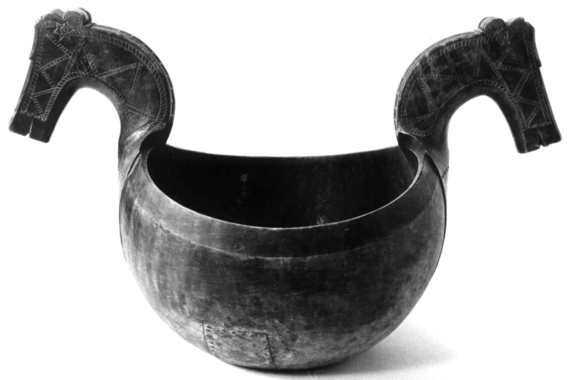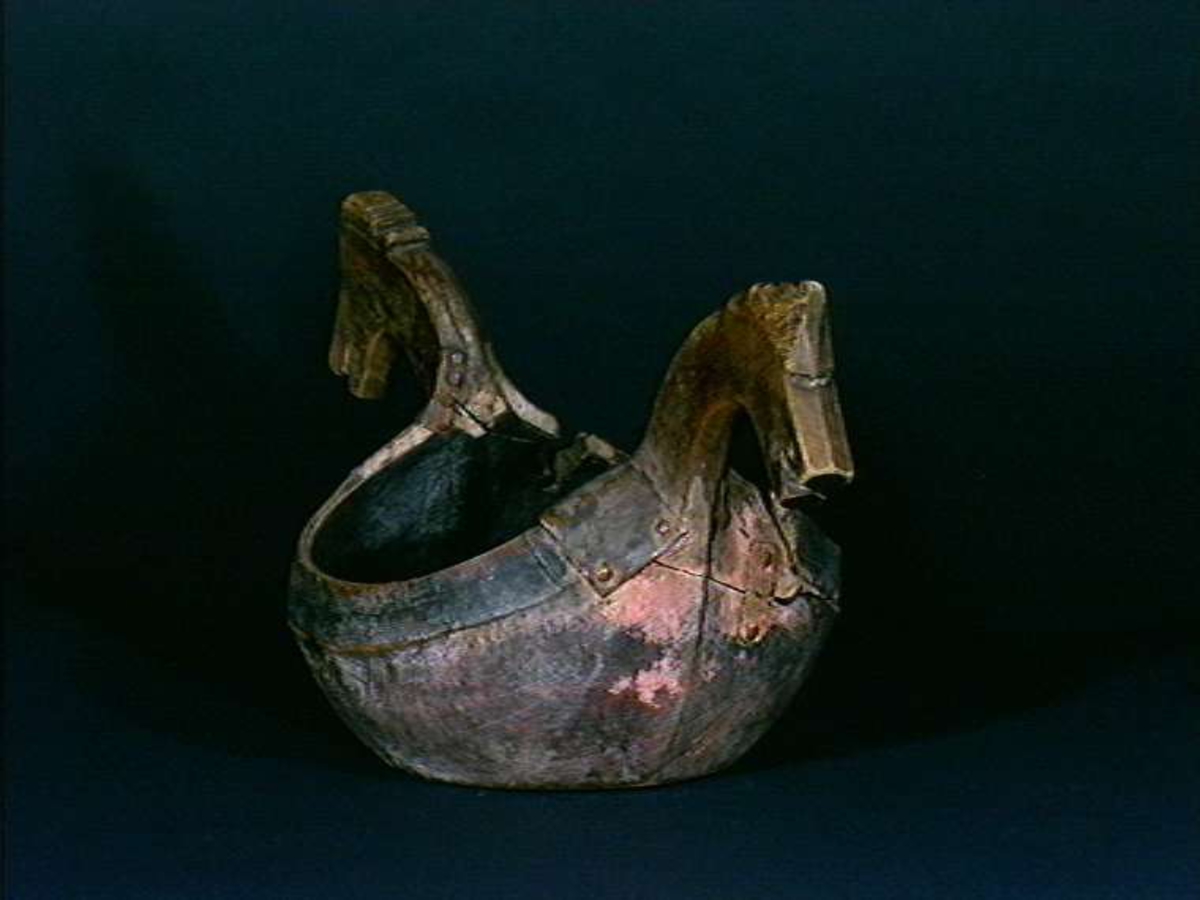Today, most people limit their drinking from bowls to the sipping of cereal milk, but there is a long tradition of drinking from bowls. Ale bowls are a rich part of that tradition. I have done a little research into carved ale bowls such as the one above recently. Even though I don’t focus on making reproductions, I think there are many lessons in carving and design in a piece like this if one just looks carefully, lessons that go beyond the specific piece.
There are subtle master touches that catch the eye. In the photo above, for example, just look at the way the thin upper edge of the rim steadily rises, broadens, then quickly returns toward the center. Lovely. I feel like the man who carved this is smiling at us from the past.
I already have a couple small ones underway (but no photos yet), trying to better understand the form and effective techniques while thinking creatively about design possibilities. As my research continues, I thought I’d share a couple resources I’ve encountered. I’d also welcome more information. I know there are many folks out there more steeped in Scandinavian culture than I have been.
It appears that this general carved form was quite popular, especially the 18th and 19th centuries in Scandinavia (particularly Norway). It is clear by the surviving examples that many carvers were creating their own variations of a common design. The horse-head theme seems to be most common, while others feature dragons, rams, or other animals. One of the more common variants are birds, such as the ale goose or ale hen.
Sizes vary from large enough to pass around a large group, as was indeed a custom, to much smaller individual drinking bowls. Just take a look at the many well-documented examples here at the Digital Museum, an online site featuring photos and information on an impressive collection of Scandinavian artifacts from many brick-and-mortar museums. The few photos I have used for this blog post are just a sampling of what is available to view there.
Like me, you will probably find that some of the specific designs are more pleasing than others. Asking oneself, “What are the elements that make this one more pleasing to my eye (or hands, or mouth) than that one?” is a key to learning from these examples as a general lesson in design. Many times these differences are subtle but quite consequential. The same sort of question can be asked when comparing many things from furniture to cars.
From a carver’s standpoint, my first question is the orientation of the piece within the log. Judging by the grain visible in some of these pieces, burls — or at least wood with figured grain — was often used, presumably to guard against splitting in a design prone to it. There are obvious weak areas of short end grain at the base of the neck and face. In fact, there are plenty of examples in the digital museum of those that did break. Many of those bear repairs that speak to the special value of these wooden bowls. Just look at this example below — now that’s tenacity!


I hope to study some original ale bowls in person sometime. The Vesterheim Norwegian-American Museum has many in their permanent collection. Chief Curator Laurann Gilbertson was very helpful when I contacted her recently. In addition to encouraging a visit to Vesterheim, she informed me of a traveling exhibit related to Scandinavian ale and spirits traditions called “Skål! Scandinavian Spirits.” The exhibit schedule is at that link. Laurann also informed me of this accompanying publication of the exhibit. I’ve learned much from it, including the translations of some of the painted inscriptions that appear on the bowls. Some are as simple as “Drink my friend, pass it to your neighbor then,” and some more reflective: “Previously I was standing in the green grove (of trees), and no one might know me, now I satisfy many a thirsty mouth.”
Here’s to ale-bowls. Skål!





Nice post. One of my favorite folk-art forms, so I appreciate the photos, too. Cheers!
LikeLike
Thanks. Beautiful violins you make, by the way.
LikeLike
Thank you, Dave. I enjoy seeing your creations. Inspiring.
LikeLike
Terrific post, Dave. Thanks.
Now… I think an IPA is in order…
LikeLike
Enjoy that Scott. I’m a wimp when it comes to heavy hops. Is it acceptable to put a little umbrella in an ale bowl?
LikeLike
Another of your great inspirations!!! I’ve been thinking of an ale bowl for a project. A local guy, Tom Dengler, has made one or two which really look very nice. Also a Ray Kjos from Rushford , MN makes ale bowls, styles from a class he took at the Vesterheim After a visit to Ray’s shop last summer I have wanted to make one of these. A trip to the Vesterheim maybe something for me to do this summer. Let me know if you are heading that way.
LikeLike
Sure thing, Paul. Thanks.
LikeLike
There are ale bowls with handles and designs clearly separating them into sections some will ‘dribble’ and the unlucky person assigned to that section. Great fun at old Viking parties
LikeLike
Very interesting, thanks. I’ll have to look into those. Considering your name, it makes sense that you might know about some Viking customs.
LikeLike
So.. what if I like stouts? do I have to drink from a fat bowl?
LikeLike
Of course.
LikeLike
David, Absolutely extraordinary. I’ll be following this closely. I would have loved to make it to your bowl carving session at Plymouth Plantation, but hopefully next year. In the meantime, I’ll be going back to Lie Nielsen’s for Peter Follansbee’s spoon carving session in May.
All the best, Gordon Hafner (from Jogge’s Crew) >
LikeLike
No worries, Gordon! Great to hear you’ll be heading back to Maine for Peter’s class. I really enjoyed the weekend at Lie-Nielsen, and I was really impressed with their business and the guys that represent it. You’re sure to have another great experience.
LikeLike
If you ever make it up to the Pacific Northwest, I would recommend the Nordic heritage museum! When I was there they had the Skal! Exhibition plus some others and you will easily fill your camera up with inspiration. I have been reading as much as possible about different treen and it is very interesting looking at all the variety that has been made. I look forward to seeing what you share!
LikeLike
Pingback: Almost Ready for Ale | David Fisher, Carving Explorations
Pingback: Norwegian Nuptials | A Riving Home
David, check out Philip Oden and Else Bigton at Norse Wood Works in Baronet, WI
Sonny Haas
LikeLike
Thanks, Sonny. I’m familiar with Philip and Else’s beautiful work in the Scandinavian tradition. I’ve never met them, but have explored their website. Inspiring.
LikeLike
Woops it’s Norsk Wood Works
LikeLike
David, when you were discussing if the bowls may have been steamed to shape, it struck me that perhaps in some cases they could have been grown to shape. A friend of mine in Fairbanks tied a knot in a birch sapling for his kids when they were little, just as an experiment for them. I recently looked at what is now a young tree, about 4 inches in diameter, still tied in a knot (overhand). Do you suppose 18th and 19th century carvers may have tied birch trees like that to get the proper curves for the head(s) and tail of some of these bowls? It might take 40 years to get wood big enough, but could it have been a tradition for a father or grandfather to start a tree for their offspring to carve when it got big enough to make their own ale bowl? Not much different of a concept than planting an orchard for your descendants to harvest. Just a thought.
LikeLike
That’s a good thought, John. I know that that sort of thing was sometimes done with future spoon blanks in mind. So it’s possible that there could have been some early human intervention for some of the blanks for those ale bowls, and I’d bet that there was. For most I think it was a matter of watching for natural crooks and curves in the trees. Your story about your friend and the birch sapling makes me want to give that a try. And the idea of sowing what future generations will reap is a comforting thought. Thanks.
LikeLike
In Scotland the double-handled Quaich are used in weddings, most are metal but the beautiful ones are carved from wood.
LikeLike
Hi Dave. I have a wooden Ale Bowl inherited from my Norwegian grandmother.
I would be happy to send you some photos if you are interested. I think ours is a lovely example!
LikeLike
Hi Peter. I’d love to see the photos, thank you! My email address is dandkfish@gmail.com
LikeLike